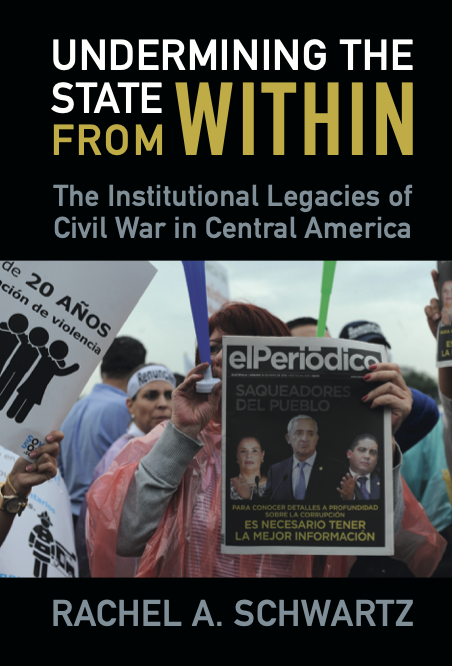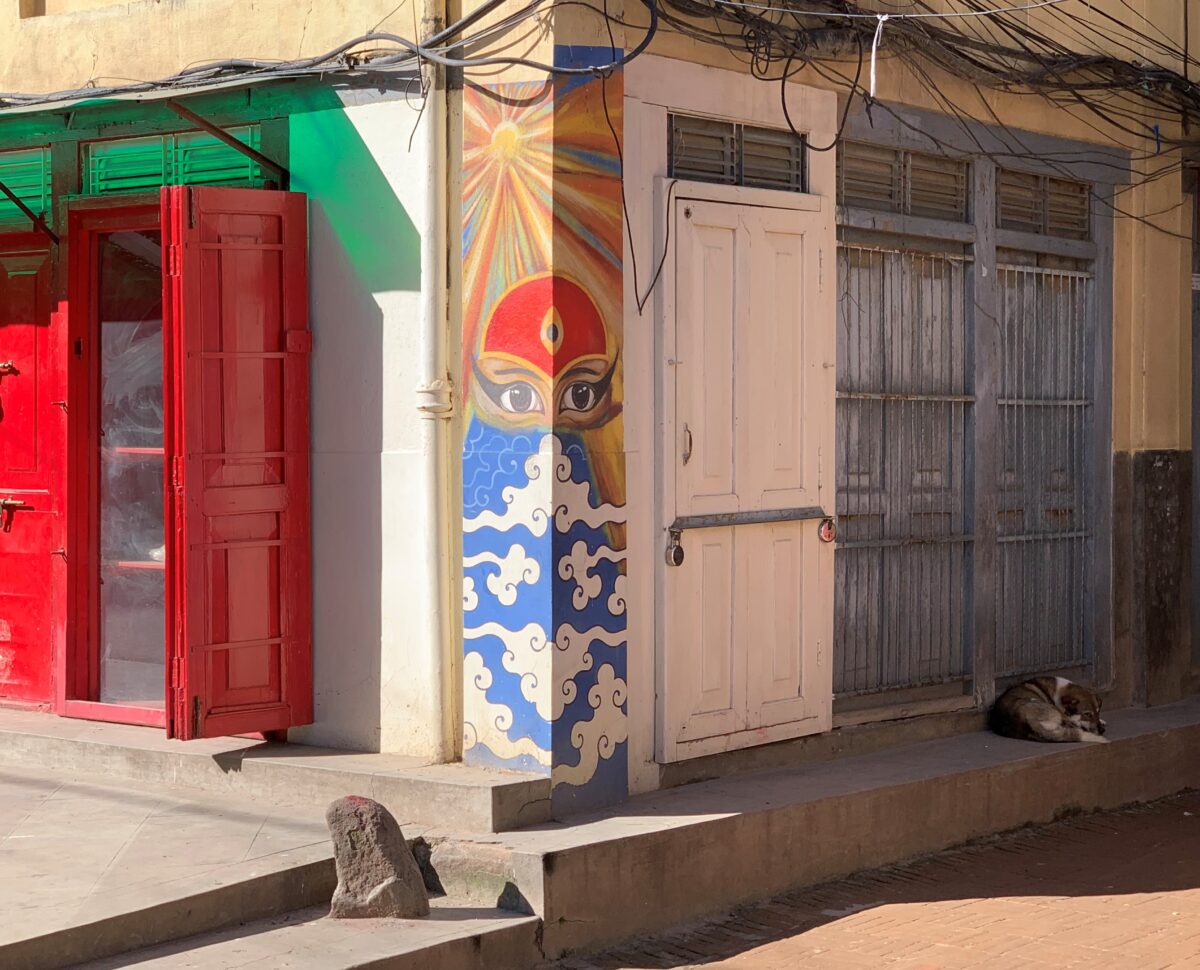
Dr. Rachel Schwartz
‘how might armed conflict itself shape state institutions and thus the possibilities of statebuilding (and peacebuilding) after the fighting has ceased?’
Within the study of civil war paths, scholars and practitioners have increasingly focused their attention on what armed conflict leaves behind. Among the central topics within this field are civil war’s legacies for political identities and participation, community cohesion, economic development, and democratization.
Yet the longer-term institutional consequences of conflict—particularly when it comes to state institutions—has been subject to less systematic inquiry. This has not, however, prevented researchers and policymakers alike from centering the need to rebuild state institutions within post-conflict peacebuilding prescriptions. As Timothy Sisk notes, statebuilding is often framed as “the telos (or end goal) of consolidating peace.”[1] Peace is contingent on the state cementing a series of rules and laws that are perceived as legitimate and that effectively establish social order.
But how might armed conflict itself shape state institutions and thus the possibilities of statebuilding (and peacebuilding) after the fighting has ceased? My new book Undermining the State from Within: The Institutional Legacies of Civil War in Central America, tackles this puzzle, first, by examining how armed conflict creates predatory institutional arrangements within the state, and then, by explaining how wartime elites preserve these alternative rules of the game following peace and governance reforms. Here, I unpack the book’s core insights on these questions through the lens of Guatemala’s war and postwar fiscal institutions and discuss the implications for how we understand statebuilding and institutional reform in the context of peacebuilding.
Civil War and the Criminalization of the State
Conflict scholarship points to both the generative and destructive institutional logics of civil war. On the one hand, classic theories link war-making and state-making, as the former induces processes of mobilization and bargaining with societal actors that construct new administrative institutions—dynamics that can apply to internal conflict, as well as interstate war. Yet, on the other hand, civil wars are defined by divided loyalties and territorial fragmentation, which can erode the reach and authority of the state.
Undermining the State from Within marries these seemingly contradictory logics by arguing that civil war is often a moment of institutional innovation, but that the resulting rules and procedures often have a corrosive effect on core state activities. As the rebel threat escalates, counterinsurgent elites—those political and military leaders tasked with designing and implementing counterinsurgent strategy and operations—enjoy greater authority and discretion and are shielded from the oversight and pressures of other actors. Amid these developments, they are able to introduce new procedures, devised under the pretext of eradicating an internal enemy, that allow them to appropriate state resources and consolidate their political grip. In this way, civil war remakes the rules of the game within the state yet does so in ways that ultimately distort state political and economic activities.
One of the book’s central institution-level cases, wartime customs fraud arrangements within Guatemala’s Ministry of Finance, illustrates this process. Using newly uncovered archival records, I illuminate how a narrow clique of military intelligence officers infiltrated the Ministry of Finance and its Directorate of Customs to establish new procedures for siphoning off extraordinary quantities of tax revenues, depriving state coffers of some $30 million on a monthly basis for nearly two decades. Guatemalan leaders justified military intelligence’s takeover of the fiscal apparatus and its centralization of authority by emphasizing the escalation of rebellion—specifically, the perceived threat of weapons smuggling to aid insurgent forces. But what ultimately emerged was a highly structured and intricate series of procedures for duplicating and altering customs forms, forging import licenses, and “disappearing” shipping containers. The counterinsurgent elites that oversaw these illicit activities formed a criminal group labeled the “Moreno Network” after its coordinator, low-level intelligence agent Alfredo Moreno.
The Moreno Network’s machinations illustrate the generative, yet perverse potential of civil war when it comes to state institutions. The militarization of the state amid counterinsurgency altered the structure of power in ways that bred institutional innovations within the tax administration. But in the words of one former Guatemalan government official, these were quite “effective institutions, but for the wrong reasons.”
How Counterinsurgent Elites Adapted the Wartime Rules of the Game Amid Peace
Authorities uncovered the Moreno Network just months before the conclusion of Guatemala’s peace process in December 1996, which, in turn, led to the complete overhaul of the tax and customs administration to dislodge the predatory procedures devised amid conflict. But in April 2015, nearly two decades later, Guatemalan and international investigators exposed a similar scheme to systematically divert customs revenue from state coffers to the pockets of top political officials, tax administration authorities, and organized crime bosses. The criminal structure was known as “La Línea”[“the Line”]. While the individual players involved were mostly different, the predatory rules enforced by La Línea were nearly identical, begging the question: how did the wartime institutional procedures survive in peacetime, given the political transition and the sweeping transformation of the fiscal apparatus?
As Guatemala’s internal armed conflict waned in the late 1980s and early 1990s, the military intelligence officers pulling the strings of the Moreno Network sought to preserve the wartime customs fraud procedures by bringing other actors into the fold—by forging a broader coalition of sectoral interests that stood to gain through the predatory rules of the game. They did so by creating a legal association comprised of politicians, judges, and military officers, which maneuvered to bribe state officials and ensure impunity for the fraudulent activities. They also garnered the buy-in of commercial elites, who benefitted economically by recurring to the illicit customs procedures.
By diversifying and widening the array of stakeholders, the counterinsurgent elite adapted and preserved the wartime rules of the game despite the dissolution of the General Directorate of Customs, the purging of customs personnel, the ouster the military intelligence architects of the Moreno Network, and the creation of a new internationally backed and independent Superintendent of Tax Administration. Political liberalization offered the counterinsurgent elites new political party vehicles through which to seize power and preserve control over customs fraud, even from outside the official spheres of government. Likewise, economic liberalization allowed the former architects of the Moreno Network to seize non-state spaces within the newly privatized port system and thus create autonomous pockets out of the reach of tax administration oversight.
By the time the postwar iteration of the criminal structure, La Línea, was uncovered during the presidency of Retired General Otto Pérez Molina, who was convicted for his role in the scheme in December 2022, the individual players had changed, but the broader sectoral interests they represented remained the same—as did the methods of arranging customs fraud, forging documents, and disappearing shipments. The wartime perversion of Guatemala’s fiscal institutions withstood decades of political turnover not because of a lack of institutional reform but because the peacetime transformations failed to dismantle the counterinsurgent coalition that systematically undermined political and economic development.
Broader Lessons for Peacebuilding and Statebuilding
These insights from the Guatemalan context suggest two key implications for understanding civil war paths, as well as related lessons for other countries in the midst of peacebuilding and statebuilding:
Post-Conflict States Are Not Blank Slates
Despite the scholarly and policy consensus that statebuilding is a fundamental component of the peacebuilding agenda, the post-conflict context is not simply a blank slate in which modern, efficient, and independent state institutions can be built anew. As the case of Guatemala’s customs administration illustrates, postwar settings must grapple with the institutional innovations devised in conflict itself and the ways in which these continue to distort state functions and activities. In this sense, and in line with Alex Waterman and James Worrall’s contribution to this blog, it is critical for researchers and practitioners to break out of the war-peace dichotomy and “to explore how pre-existing forms of order can outlive conflicts and reassert themselves in the post-conflict environment.”
Of course, wartime institutional changes are not deterministic—we cannot simply draw a straight line between the rules developed amid counterinsurgency and the institutions that define the post-conflict state. As Civil War Paths director Anastasia Shesterina has written, social, political, and economic outcomes in the postwar period may result from processes not directly related to conflict, including those confined to the post-conflict landscape itself. But to the extent civil war does breed perverse, predatory practices that distort state functioning, the peacebuilding moment might require sustained efforts to unmake state institutions, rather than simply remake them.
Post-Conflict Statebuilding Is About Much More Than ‘The State’
Relatedly, Undermining the State from Within’s key insights on wartime institutional innovation and postwar institutional persistence also underscore the reality that reforming state institutions requires much greater attention to actors and interests that reside outside the formal state sphere.
As the case of the Moreno Network, and its postwar successor La Línea, demonstrates, the survival of the illicit customs procedures cannot simply be attributed to its architects continuing to hold formal political office following peace. Instead, anticipating the return to civilian rule, military intelligence elites strategically cultivated a broad state and non-state coalition comprised of diverse actors with a stake in wartime customs fraud. Even with relatively extensive efforts to purge from official power the top officials responsible for orchestrating the Moreno Network, political and economic transition afforded them new semi- and non-state spaces—political parties, private port enterprises, organized crime syndicates—through which to uphold the wartime rules of the game and ensure impunity.
In short, postwar policy prescriptions must widen their analytical lens to better capture how an array of private actors continues to benefit from the preservation of wartime political and economic orders.
You can find an excerpt of Undermining the State from Within here.
[1] Timothy Sisk, Statebuilding (Cambridge, UK: Polity), x.

